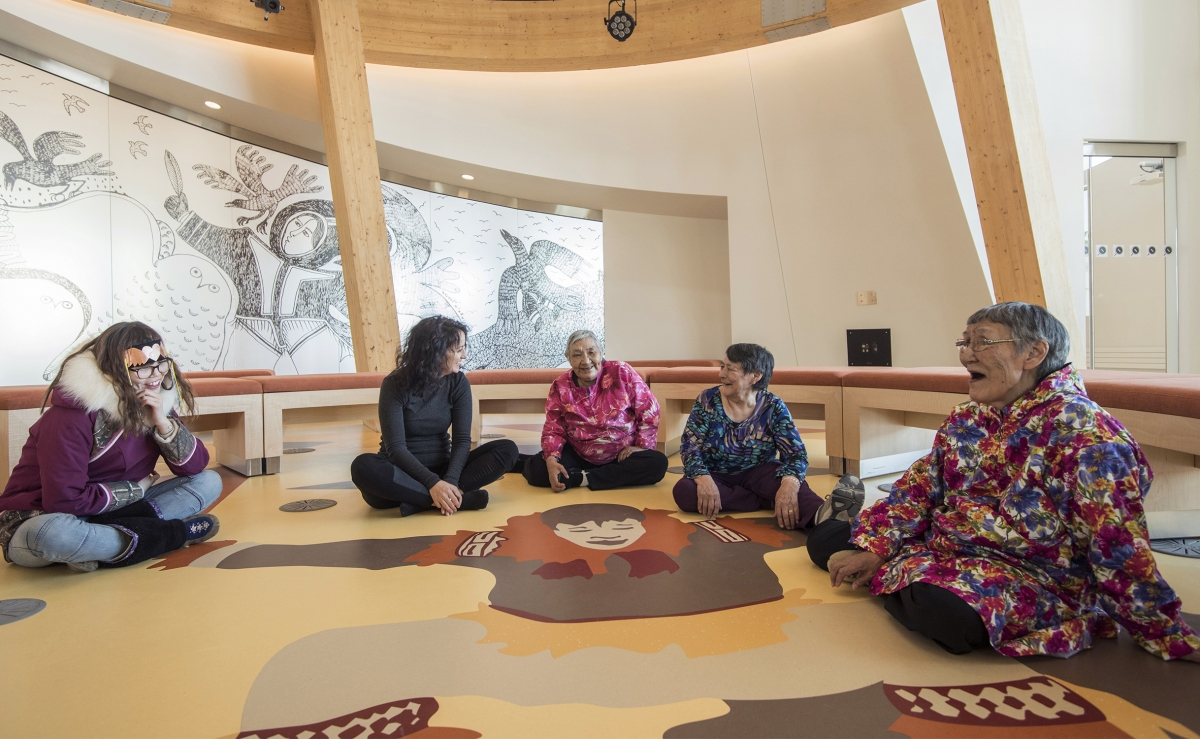Broadcasting live from Iqaluit, Nunavut on March 19, Aaju Peter lit and kindled a small fire over a large stone tub of oil as students, professors, and artists witnessed the flame spread. By lighting the qulliq—a traditional oil lamp used by Arctic Indigenous Peoples—Peter commenced Inuit Qaujimajatuqangit: Traditional Knowledge in the Contemporary World, an online round table showcasing Inuit culture and wisdom. The qulliq’s lighting reflected the round table’s thematic emphasis on historical and contemporary Inuit cultural practices.
“Inuit survived out on the land in small groups and in families, not dependent on anything from the outside world, using the qulliq to melt the water [and] to light and warm their igloo or sod house,” Peter said in an interview with The McGill Tribune. “In today’s world, where we do not use the qulliq everyday, it has become a symbol for remembering our traditions and our ancestors. [We] also use the qulliq as the welcoming tool to start important meetings [and] gatherings, and to welcome participants to the territory or to the meeting.”
Hosted by the McGill Provost’s Task Force on Indigenous Studies and Indigenous Education, the event featured Inuit and non-Inuit scholars, artists, and activists from across Inuit Nunaat and Lower Canada. Each speaker presented on different aspects of Inuit cultures, such as music, environmental practices, and architecture. Danish journalist and ethnomusicologist Karsten Sommer explored the history of Greenlandic [Kalaalit Nunaat] music. Starting with Greenlandic drum history that spans thousands of years and ending with modern Greenlandic hip-hop, Sommer traced the history of Inuit music and its transformation during Denmark’s colonization of Greenland.
“When the missionaries arrived to West Greenland in 1721, they presented what also became accepted as a part of Greenlandic traditional music, like choir-singing,” Sommer said. “They taught [the Inuit] the pleasure of singing in choir, and still today, all towns and villages in Greenland have their local choirs. Later, the whalers came from Europe […] and played their local polka and introduced violins and accordion.”
Sommer’s presentation was one of many that explored the diversity and vitality of Inuit cultures and practices. While topics varied, the presenters were all acquainted with one another, and had been invited by Marianne Stenbaek, a cultural studies professor at McGill. Stenbaek, along with teaching assistants Elizabeth La Rocque, Emily Hoppe, and Pascale Théorêt-Groulx, organized the event.
“I have been interested in storytelling and in Inuit culture, [and] how these ideas have come about, and been passed on for centuries,” Stenbaek said. “[Inuit knowledge] used to be totally disregarded, and researchers would go and just do whatever they felt like. But now, more and more, it has become imperative that researchers […] take the local knowledge into account.”
During the round table, Provost and Vice-President (Academic) Christopher Manfredi expressed hope that McGill’s proposed campus master plan, which intends to display Indigenous art on campus, will cultivate a welcoming environment for Indigenous students at McGill.
“Some […] Indigenous elements, such as elevating the status of and the importance of La Hochelaga Rock, [have] already [been] achieved,” Manfredi said. “A lot of it is around landscaping, the use of art, the naming of buildings, giving greater visibility to our First Peoples house, and providing spaces for ceremonial activities. We are seeking reconciliation through the development of the master plan.”
The virtual round table offered a platform for sharing Indigenous knowledge and respecting Indigenous communities in Canada and across the world.
“When I went to school […], I was not taught my own language in Denmark and also in Greenland,” Peter said. “There was a time where we were all shipped off to learn to speak the white man’s language. [This event supports] taking back what was inherently ours at birth, and from our culture, and taking back the pride of being able to practice our own language [and] our own stories of our own people.”










Hello Lowell Wolfe, just a quick note that the Roundtable prof. Marianne Stenbeak put together took his root with the Inuit Qaujimajatuqangit exhibition we (EVOQ) put together as a whole process (IQ) from the design of the Canadian High Arctic Research Station (CHARS) , until the art integration into the building via the pan Canadian Inuit Art Competition I managed (see the picture of your article). Soon after, I sought out a partnership with McGill University (Christopher Manfredi). All this led to this roundtable day and was the topic of my lecture. Unfortunately, you may not have the opportunity to hear it (you certainly heard Sommer’s one ;)). Thank you for this coverage though.